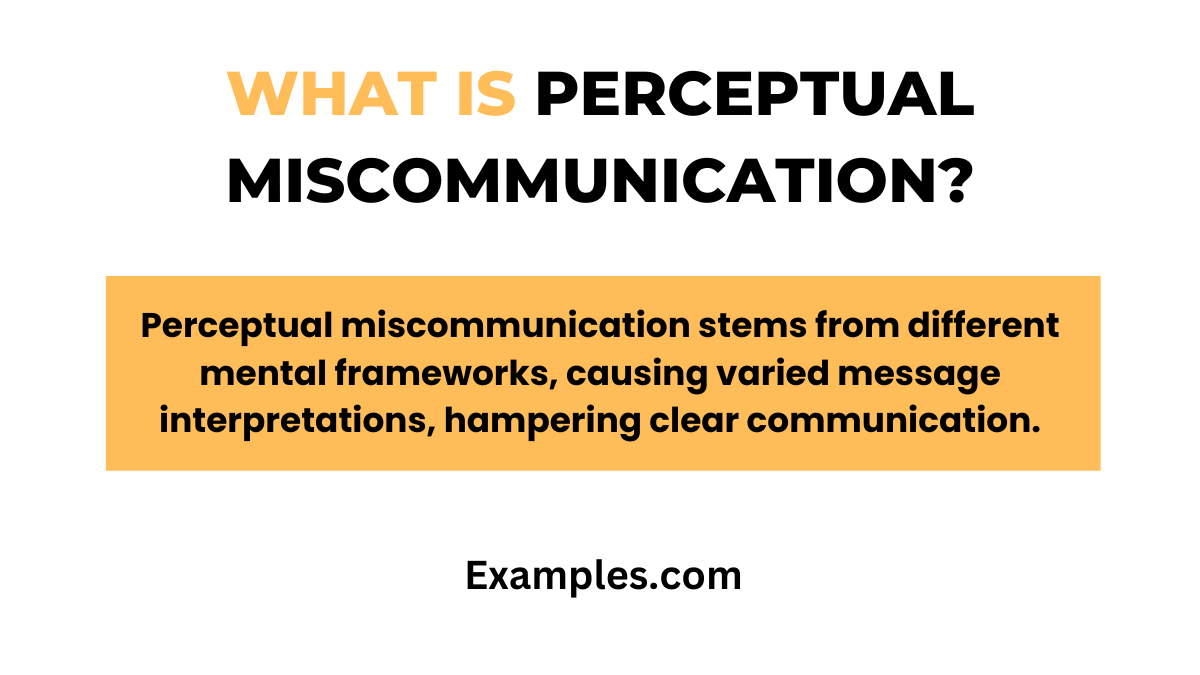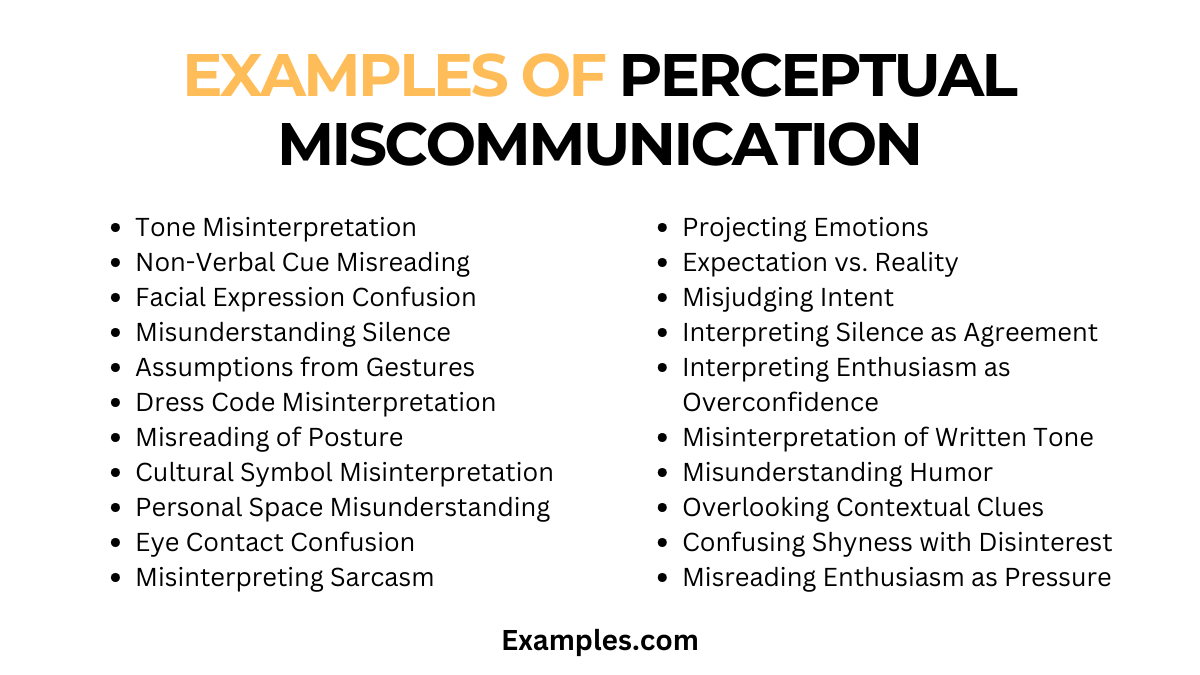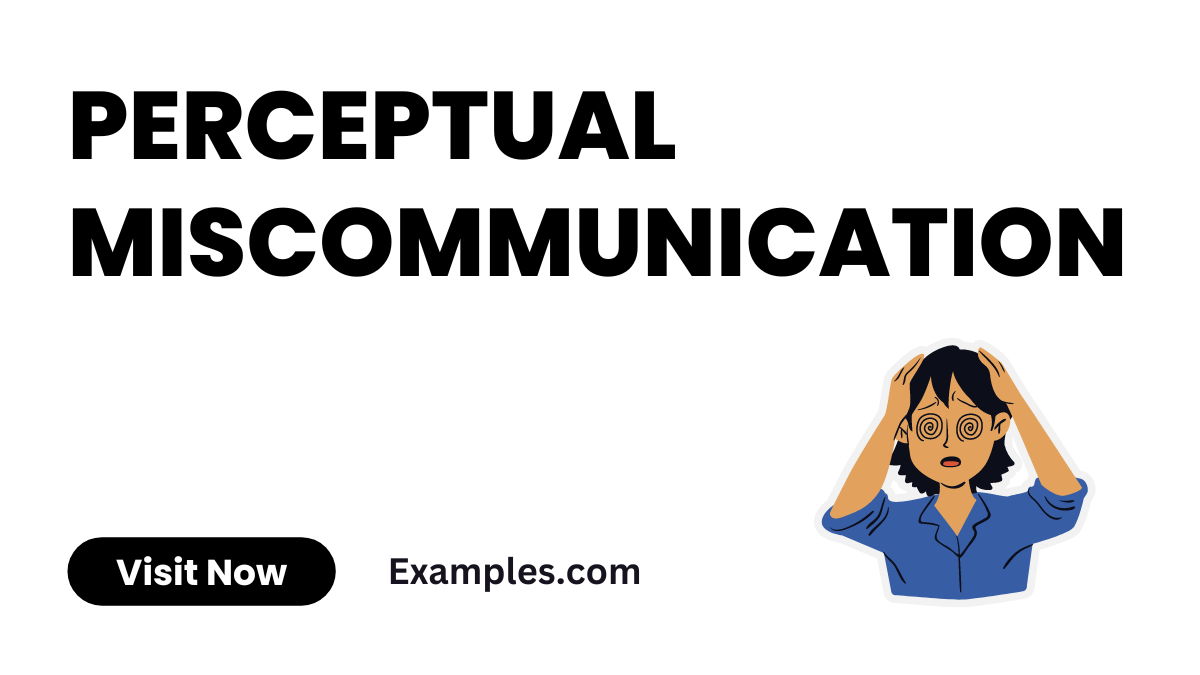Perceptual Miscommunication
Perceptual miscommunication occurs when individuals interpret messages differently based on their unique perceptions. This discrepancy can lead to a range of misunderstandings, affecting both personal and professional interactions. Our guide dives into miscommunication examples, showcasing how subtle perceptual differences can significantly impact communication. We explore various scenarios where these misunderstandings arise, offering insights and tips to recognize and address them effectively. Understanding perceptual miscommunication is crucial in a world where clear communication is key to success.
What is Perceptual Miscommunication?

Perceptual miscommunication refers to a situation where individuals interpret or perceive the same message differently due to their unique mental frameworks and experiences. This variance in perception can lead to misunderstandings, as each person’s interpretation of the message might differ significantly from the intended meaning. It often occurs in both verbal and non-verbal communication, where gestures, tone of voice, and cultural backgrounds play a crucial role in how messages are received and understood. Recognizing and addressing perceptual miscommunication is essential for effective and clear communication.
What is the best Example of Perceptual Miscommunication?

A classic example of perceptual miscommunication is the interpretation of a simple gesture or phrase differently across cultures. For instance, a thumbs-up sign is generally considered a positive gesture in many Western cultures, signifying approval or agreement. However, in some Middle Eastern cultures, this same gesture can be seen as offensive or disrespectful. This demonstrates how cultural perceptions can significantly alter the meaning of a message, leading to miscommunication and potential conflicts if not recognized and addressed with sensitivity and awareness.
25 Perceptual Miscommunication Examples

Perceptual miscommunication arises when individuals interpret messages based on their perceptions, leading to misunderstandings. It’s a common obstacle in conveying clear messages, significantly impacting interactions. This type of miscommunication can be subtle yet pervasive, often causing significant discrepancies in understanding and interpretation.
1. Tone Misinterpretation: John thought his boss was angry due to her stern tone, but she was just stressed.
Example: “I noticed your tone seemed firm. Are you upset with me, or is there another stressor?”
2. Non-Verbal Cue Misreading: Sara mistook her colleague’s crossed arms for disinterest, not realizing he was just cold.
Example: “I see you’re crossing your arms. Are you feeling disengaged, or is it something else?”
3. Facial Expression Confusion: Mike interpreted his friend’s frown as disapproval, but he was actually concentrating.
Example: “Your expression seems serious. Are you disapproving of my idea?”
4. Misunderstanding Silence: Emma thought her partner’s silence meant agreement, but he was actually unsure.
Example: “You’ve been quiet. Does this mean you agree, or are you uncertain?”
5. Assumptions from Gestures: Alex assumed his teammate’s nod meant comprehension, but it was just a polite gesture.
Example: “I see you nodding. Do you fully understand, or should I clarify further?”
6. Dress Code Misinterpretation: A formal dress at a casual event led to assumptions of arrogance.
Example: “Your attire is quite formal. Was this a personal preference for today’s event?”
7. Misreading of Posture: Lena’s slouch was seen as disinterest, not fatigue.
Example: “I notice your posture. Are you disinterested, or is something else going on?”
8. Cultural Symbol Misinterpretation: A thumbs-up was interpreted as agreement instead of an offensive gesture in a different culture.
Example: “In your culture, does this gesture have the same meaning as in mine?”
9. Personal Space Misunderstanding: Standing too close was seen as intrusive, not friendly.
Example: “Am I standing too close for your comfort?”
10. Eye Contact Confusion: Direct eye contact was interpreted as aggression, not attentiveness.
Example: “Does my eye contact make you uncomfortable, or is it acceptable?”
11. Misinterpreting Sarcasm: A sarcastic remark was taken literally, leading to confusion.
Example: “Was that sarcasm, or should I take your words at face value?”
12. Projecting Emotions: Feeling anxious, a manager misinterpreted team calmness as complacency.
Example: “I’m feeling anxious. Are you all genuinely content with the current situation?”
13. Expectation vs. Reality: Expecting a cheerful greeting, a frown was misread as displeasure.
Example: “I expected a smile. Is there something bothering you?”
14. Misjudging Intent: A friendly gesture was mistaken for flirting.
Example: “I interpreted your gesture as flirting. Was that your intention?”
15. Interpreting Silence as Agreement: A team member’s silence was mistaken for consensus.
Example: “You haven’t voiced an opinion. Do you agree with the decision?”
16. Interpreting Enthusiasm as Overconfidence: High energy was misread as lack of humility.
Example: “Your enthusiasm is evident. Are you confident or exploring options?”
17. Misinterpretation of Written Tone: An email’s formal tone was mistaken for coldness.
Example: “Your email seemed formal. Is everything alright between us?”
18. Misunderstanding Humor: A joke was taken as a serious statement.
Example: “Was that a joke, or should I take it seriously?”
19. Overlooking Contextual Clues: Ignoring the context led to misinterpreting a colleague’s remark.
Example: “Considering the context, were you being facetious?”
20. Confusing Shyness with Disinterest: A shy person’s lack of engagement was mistaken for disinterest.
Example: “Are you disinterested, or just feeling shy?”
21. Misreading Enthusiasm as Pressure: Enthusiastic advice was perceived as pressuring.
Example: “Is this advice coming from enthusiasm or are you pressuring me?”
22. Misconstruing Professionalism as Unfriendliness: Professional distance was misinterpreted as unfriendliness.
Example: “Are you maintaining professional distance, or are you unhappy with me?”
23. Interpreting Casual Attitude as Unprofessionalism: A relaxed demeanor was misread as a lack of professionalism.
Example: “Your casual approach is noted. Is this your usual professional demeanor?”
24. Misinterpreting Patience as Indifference: Patient listening was mistaken for lack of interest.
Example: “Your patience is appreciated. Are you interested or indifferent?”
25. Confusing Assertiveness with Hostility: Assertive communication was seen as hostile.
Example: “Your assertiveness is clear. Are you being hostile or just firm?”
What are the barriers to Perceptual Miscommunication?
- Cognitive Biases: Our pre-existing beliefs and expectations often color our perception, leading to misinterpretation of messages.
- Cultural Differences: Variations in cultural norms and non-verbal cues can lead to perceptual barriers in understanding.
- Personal Experiences: Individual experiences shape how we perceive and interpret information, potentially leading to miscommunication.
- Emotional State: Being in a particular emotional state (like anger or happiness) can skew our perception of what others communicate.
- Physical Environment: The surroundings in which communication takes place can influence how messages are perceived and understood.
- Language Barriers: Differences in language or dialect can lead to misunderstandings, as certain nuances might be lost.
- Non-Verbal Misinterpretation: Misreading body language, facial expressions, or gestures can lead to perceptual miscommunication.
- Technological Mediation: Reliance on technology for communication (like emails or texts) can strip away important contextual cues.
- Lack of Clarity: Ambiguous or vague communication can easily be misinterpreted, leading to different perceptions of the same message.
- Psychological Factors: Personality traits, such as introversion or extroversion, can affect how we interpret messages from others.
Perceptual Miscommunication In the workplace
- Misinterpreting Feedback: Constructive criticism can be perceived as personal attack, leading to defensive reactions.
- Conflicting Interpretations of Policies: Employees may perceive organizational policies differently, leading to confusion and conflict.
- Misunderstanding Team Dynamics: Misinterpreting colleagues’ behavior or responses can lead to tension in team interactions.
- Differing Perceptions of Urgency: What one perceives as urgent, another might see as a low priority, affecting task prioritization.
- Interpreting Tone in Written Communication: Emails and memos can often be misinterpreted due to the lack of vocal tone.
- Confusing Professional Boundaries: Misinterpreting colleague’s friendliness as an invitation to overstep professional boundaries.
- Assuming Understanding: Overestimating a colleague’s understanding of instructions or expectations can lead to task failures.
- Projecting Emotions on Others: Projecting one’s own stress or frustration onto colleagues, misinterpreting their intentions.
- Misreading Leadership Styles: Interpreting a leader’s management style through one’s own perceptual lens, leading to misconceptions.
- Differences in Work Styles: Varied approaches to work can be misunderstood, leading to assumptions about colleagues’ dedication or competence.
Perceptual miscommunication, often rooted in our subjective interpretation of messages, can significantly impact personal and professional relationships. Understanding its causes and actively seeking clarification can improve communication efficacy. Employing empathetic and clear communication strategies is key to mitigating such misunderstandings.



